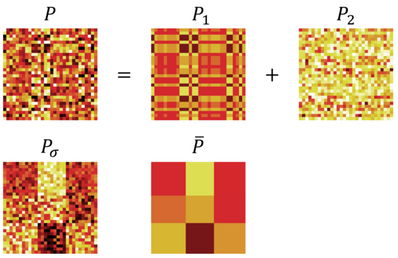马尔科夫链的粗粒化
马尔科夫矩阵是指满足每一行和为1的条件的方阵,而马尔科夫链指的是一个n维的状态的序列[math]\displaystyle{ x_t\ = \{1, ..., n\}_{t} }[/math],每一步的状态转换都有马尔科夫矩阵[math]\displaystyle{ P }[/math]决定,即[math]\displaystyle{ x_{t+1} = x_t P }[/math]。
[math]\displaystyle{ P }[/math]的每一行对应的每个状态转移到其他状态的概率。比如当[math]\displaystyle{ x_t }[/math]等于第一个状态的时候,[math]\displaystyle{ P }[/math]的第一行展示了[math]\displaystyle{ x_{t+1} }[/math]状态的概率。
对马尔科夫链做粗粒化做粗粒化的意义是什么呢?我们看到文献中着重强调这两点:
- 我们在研究一个超大的系统的时候,比如复杂城市系统时,并不会关注每一个微观的状态的变化,在粗粒化中我们希望能过滤掉一些我们不感兴趣的噪声和异质性,而是想从中微观尺度中总结一些中尺度或宏观尺度的规律;
- 有些状态的转移概率非常相似,所以可以被看成同一类状态,对这种马尔科夫链做partitioning可以减少系统表示的冗余性;
- 在用到马尔科夫决策过程的强化学习里,对马尔科夫链做粗粒化可以减少状态空间的大小,提高训练效率。
粗粒化
马尔科夫链不只是一个马尔科夫矩阵那么简单,还涉及到了不同的状态,也会有状态之间的转移概率,所以我们可以从不同的角度来看待粗粒化:
- 对马尔科夫矩阵做粗粒化:在看待一个方阵时,我们可以把它想象成一个网络的邻接矩阵。节点为状态,连边为状态转移概率,而粗粒化则是对这个网络做降维。
- 对状态空间做粗粒化:我们这里讨论的是离散状态的马尔科夫链,状态空间的大小等于马尔科夫链的大小。粗粒化可以看作对状态空间做分组并投影到新的状态空间。
- 对转移概率做粗粒化:从概率论出发,把状态的发生看作事件,通过计算事件发生的频率来构建概率空间。在降维表达事件的同时也构建了新的概率空间。
这三种出发点看似互有联系,但是具体关心的东西不同。第一种关注状态之间的连边拓扑结构,第二种关注不同状态的历史分布和相似性,第三种关注如何降维表达整个系统中的事件概率分布。
对马尔科夫链做粗粒化并没有一个统一的定义,目前该题目也没有一个完整的文献综述。在许多文献中,粗粒化coarse-graining和降维dimension reduction是重叠等价的。
多数文献中会出现如此一个定义:
对状态空间[math]\displaystyle{ S }[/math]和转移函数[math]\displaystyle{ T(t):S-\gt S }[/math],我们需要一个投影矩阵[math]\displaystyle{ R:S-\gt S' }[/math],和一个新的转移函数[math]\displaystyle{ T'(t):S'-\gt S' }[/math],而且S'和T'要符合马尔科夫链定义。
所以,我们能看出[math]\displaystyle{ R }[/math]是一个对状态空间[math]\displaystyle{ S }[/math]的降维函数(得到[math]\displaystyle{ S' }[/math])。而且,我们还需要把[math]\displaystyle{ T }[/math]降维成[math]\displaystyle{ T' }[/math]。如果[math]\displaystyle{ T:s_{t+1} = s_{t} P }[/math],[math]\displaystyle{ P }[/math]为离散马尔科夫矩阵的话,这个针对马尔科夫矩阵的降维可以表示为
[math]\displaystyle{ P' = W P V, }[/math]
其中[math]\displaystyle{ P \in \mathbb{R}^{n \times n} }[/math],[math]\displaystyle{ P' \in \mathbb{R}^{k \times k} }[/math],[math]\displaystyle{ W \in \mathbb{R}^{k \times n} }[/math],[math]\displaystyle{ V \in \mathbb{R}^{n \times k} }[/math]。Buchholz[1]的文章中把[math]\displaystyle{ U }[/math]称作distributor matrix,而[math]\displaystyle{ V }[/math]称作collector matrix。
马尔科夫链的粗粒化可以分成Hard partitioning和Soft partitioning。Hard partitioning是指把若干个微观状态分成一个宏观状态类,且一个微观状态不能同时属于多个宏观状态类,而soft partitioning则会有可能出现这种情况。
在hard aprtitioning的情况下,[math]\displaystyle{ V_{i, j} = 1\ if\ s_i \in s_j'\ and\ 0\ otherwise }[/math]。而[math]\displaystyle{ W = D^{-1}(V)^T, D = diag(\alpha V) }[/math],其中[math]\displaystyle{ \alpha }[/math]是一个非负对角矩阵。
所以,我们能看到,对马尔科夫链做粗粒化的时候,不仅要对状态空间做降维([math]\displaystyle{ R }[/math]),还要对马尔科夫矩阵都要做降维([math]\displaystyle{ V }[/math]),当中也包含了对概率空间的降维([math]\displaystyle{ W }[/math])。
而且,有文献中还提到了粗粒化的交换律commutative。按照上面的定义,[math]\displaystyle{ s_t }[/math]有两个路径能达到[math]\displaystyle{ s_{t+1}' }[/math]:
- 先得到下一步的[math]\displaystyle{ s_{t+1} = s_{t} P }[/math],再做粗粒化得到[math]\displaystyle{ s_{t+1}' = R(s_{t+1}) }[/math]
- 先做粗粒化得到[math]\displaystyle{ s_{t}' = R(s_{t}) }[/math],再得到下一步的[math]\displaystyle{ s_{t+1}' = s_{t}' P }[/math]
而交换律则要求从这两条路径得到的结果应该是一样的,即[math]\displaystyle{ R(s_{t} P) = R(s_{t}) P }[/math]。
马尔科夫链的粗粒化可以分成Hard partitioning和Soft partitioning。Hard partitioning是指把若干个微观状态分成一个宏观状态类,且一个微观状态不能同时属于多个宏观状态类,而soft partitioning则会有可能出现这种情况。
我们这里主要讨论hard partitioning,主要参考的是Anru Zhang和Mengdi Wang的Spectral State Compression of Markov Processes[2]。
Rank
首先讨论的是一个马尔科夫矩阵的rank秩。
大家理解的线代里的rank秩的定义是看矩阵中的线性无关的行向量的数量,但是这里对秩的理解是从一种类似于信道的概念。
秩的定义为我们能找到的一组概率密度函数 [math]\displaystyle{ f_1, ... , f_r, g_1, ... , g_r }[/math],使得r在下列公式里最小:
[math]\displaystyle{ P(X_{t+1} | X_{t}) = \sum^r_{k=1} f_k(X_t) g_k(X_{t+1}) }[/math]
这里的秩的意思是,我们能多大程度上压缩信道,使得信息在宽度为秩的信道中无损传递。(笔者个人理解)
在n个离散状态的马尔科夫矩阵中,[math]\displaystyle{ f_1, ... , f_r, g_1, ... , g_r }[/math] 是维度为n的矩阵。
而我们能定义r × r的markov kernel [math]\displaystyle{ C = \{C_{ij} = \sum_{k=1}^n f_j(k)g_i(k)\} }[/math],[math]\displaystyle{ f_1, ... , f_r }[/math] 为 left Markov features,[math]\displaystyle{ g_1, . . . , g_r }[/math] 为 right Markov features.
这个定义可以想象成可压缩的程度,也会是下面的hard partitioning的分组的数量。
Lumpability
Lumpability是一种用于分类的定义,笔者暂时还没找到一个正式的中文翻译,而不同文献对于这个概念的解释也有所不同。
这个概念最早出现在Kemeny, Snell 1976. Finite Markov Chains中。书中的定义是这样的
给定一个partition [math]\displaystyle{ A=\{A_1, A_2, ... ,A_r\} }[/math],我们能够用下列公式描述一个粗粒化后的马尔科夫链(lumped process),且这个转移概率对任何初始状态(starting vector) [math]\displaystyle{ \pi }[/math] 都是一样的:
[math]\displaystyle{ Pr_{\pi}[f_0 \in A_i] }[/math]
[math]\displaystyle{ Pr_{\pi}[f_1 \in A_j | f_0 \in A_i] }[/math]
[math]\displaystyle{ Pr_{\pi}[f_n \in A_t |f_{n-1} \in A_s, f_1 \in A_j, f_0 \in A_i] }[/math]

作者提出了判断一个马尔科夫链对给定partition [math]\displaystyle{ A=\{A_1, A_2, ... ,A_r\} }[/math] 是否lumpable的充分必要条件为:
对于任意一对[math]\displaystyle{ A_i, A_j }[/math],每一个属于[math]\displaystyle{ A_i }[/math]的状态[math]\displaystyle{ s_k }[/math]的[math]\displaystyle{ p_{kA_j} }[/math]都是一样的。
也就是说[math]\displaystyle{ p_{s_k A_j} = \sum_{s_m \in A_j} p_{s_k s_m} = p_{A_i A_j}, k \in A_i }[/math]。
这个公式表达的是,群组[math]\displaystyle{ A_i }[/math]到群组[math]\displaystyle{ A_j }[/math]的转移概率 = 群组[math]\displaystyle{ A_i }[/math]中任意状态[math]\displaystyle{ s_k }[/math]到群组[math]\displaystyle{ A_j }[/math]的转移概率 = 群组[math]\displaystyle{ i }[/math]中任意状态[math]\displaystyle{ s_k }[/math]到群组[math]\displaystyle{ A_j }[/math]中的状态的转移概率的和。
由此公式我们能获得一个直观上的说法:当马尔科夫矩阵存在block结构,或者状态明显可被分成几种partition的时候,该矩阵就会lumpable,如图一中的[math]\displaystyle{ \bar{P} }[/math]所示。
但是,有时候有些lumpable的矩阵的状态排序被打乱了(如图一中的[math]\displaystyle{ P_1 }[/math]),或者矩阵包含了如[math]\displaystyle{ P_2 }[/math]的噪声(如图一中的[math]\displaystyle{ P }[/math],[math]\displaystyle{ P = P_1 + P_2 }[/math],[math]\displaystyle{ P_1^TP_2 = 0 }[/math])。
基于Lumpability的粗粒化方法
我们在实际问题中很多时候要面对的是像[math]\displaystyle{ P }[/math]这样的矩阵,我们既无法确定它是否lumpable,也无法决定它的partition,我们甚至不知道它的马尔科夫秩。
在这种情况下,Anru Zhang[2]的文章中提供了一种寻找最优partition的方法,通过此方法我们能找到最优的partition,代入这个partition我们就能通过上面的充分必要条件来决定一个马尔科夫矩阵是否lumpable。具体步骤如下:
- 先获取一个n*n维的马尔科夫矩阵P,或者是马尔科夫链的频率采样;
- 获取r<n 的马尔科夫秩,或指定一个r;
- 对P进行SVD分解,[math]\displaystyle{ P = U \Sigma V^T }[/math],其中U为左奇异向量,V为右奇异向量。
- 通过下列公式得到最优partition [math]\displaystyle{ \Omega_1, \Omega_2, ... , \Omega_r }[/math]
[math]\displaystyle{ \Omega_1, \Omega_2, ... , \Omega_r = argmin_{\Omega_1, \Omega_2, ... , \Omega_r} min_{v_1, v_2, ... , v_r} \sum_{s=1}^r \sum_{i \in \Omega_s} || V_{[i,:r]} - v_s ||_2^2 }[/math]
其中,[math]\displaystyle{ v_s }[/math]是第s类[math]\displaystyle{ \Omega_s }[/math]的特征向量。
这个算法的意思是在最优的partition中,[math]\displaystyle{ \Omega_s }[/math]中的状态[math]\displaystyle{ i }[/math]的右奇异向量会和[math]\displaystyle{ v_s }[/math]距离最小,也就是说,让每个微观态的右特征向量和它对应的宏观态的右特征向量尽可能接近。
这个看起来非常眼熟,其实它就是在做kMeans聚类算法。让[math]\displaystyle{ v_s }[/math]和组里的[math]\displaystyle{ V[i:r] }[/math]距离最小的方法,就是让[math]\displaystyle{ v_s }[/math]成为[math]\displaystyle{ V[i:r] }[/math]这若干个点的中心。
回顾一下kMeans算法把n个点聚成r类的目标函数,其中第[math]\displaystyle{ i }[/math]个点被归到第[math]\displaystyle{ c^i }[/math]类,而[math]\displaystyle{ \mu_j }[/math]为第[math]\displaystyle{ j }[/math]类点的中心点:
[math]\displaystyle{ J(c^1, ... , c^n, \mu_1, ... , \mu_r) = \sum_{i=1}^n || x_i - \mu_{c^i} ||^2 }[/math]
我们看到这两个目标函数是非常相似的。所以,我们就可以通过上述算法或者kMeans来获取最优partition,然后根据这个partition来判断马尔科夫矩阵的lumpability。
因果涌现
有效信息
有效信息相关详情请参照因果涌现词条。
Dynamical Reversibility 动力学可逆性
动力学可逆性相关详情请参照因果涌现词条。
因果态
因果态相关详情请参照计算力学词条。
不同粗粒化方法之间的异同
动力学可逆性 v.s. Lumpability
在lumpability的图1中我们提到了lumpable的马尔科夫矩阵可以被重新排列成几个block,这种lumpable的矩阵的动力学可逆性也会很高,在这种情况下动力学可逆性和 Lumpability是一致的。
在没有明显block结构的情况下,我们可以使用上述的SVD+kMeans方式找到最优的lumpability partition并决定它的lumpability。我们在一个动力学可逆性比较高(有明显的因果涌现)的国际贸易网的例子上尝试了一下,却发现该网络上的最优lumpability partition宏观结果的动力学可逆性并不高。这现象说明:
- Lumpability最优的partition不等于可逆性最优的partition。
- Lumpability的分组数量是基于马尔科夫秩的,而可逆性的分组数量是对奇异值谱的截断位置。
(未完待续)